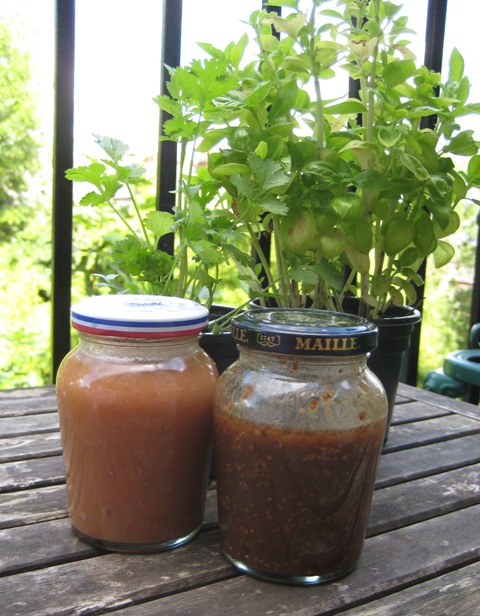Vinaigrettes - here’s one that I prepared earlier
 Wednesday, July 28, 2010 at 9:59PM
Wednesday, July 28, 2010 at 9:59PM 
I have two core vinaigrettes that I make up in jars and always have ready in the fridge to use as salad dressing. They keep for ages, the only fresh ingredient (garlic) being preserved by the vinegar and oil. Since I will refer to these a lot in my recipes I thought I should do a separate post on them, so as not to continually be repeating myself.
Just a little point of trivia – always one to err on the side of caution, I was doing some research to ensure this was the correct use of the term ‘vinaigrette’. I was concerned that in order to fit the definition, the preparation must involve the slow pouring and whisking of oil into vinegar to create a creamy emulsion. As it turns out, this is just a style of making vinaigrette, but by no means a definition.
My first port of call was Wikipedia, which confirmed my suspicions:
There are many ways to prepare vinaigrette but the basic recipe is to slowly add 3 parts of oil at room temperature to 1 part of vinegar, using a whisk, until it emulsifies into a creamy sauce.
I wasn’t satisfied with this, so I consulted the Larousse Gastronomique, which I was surprised to find did not have any entry for vinaigrette at all. I tried salad dressings instead and found a recipe for basic vinaigrette described thus:
Prepare a basic vinaigrette with 1 tablespoon wine vinegar, 3 tablespoons olive oil (or chosen salad oil), salt, pepper and, if desired, 1 teaspoon mustard. This vinaigrette can be varied in many ways.
That’s it. No mention of whisks or emulsions. And it has to be said that Larousse has more authority on gastronomic, gastronomique, matters than Wikipedia.
Even so, I have taken Wikipedia’s example and given my measurements as ratios so that you can adapt the recipe according to your needs. In my case the size of the batch is dependent on the size of the jar, but you may prefer to make just enough for the salad you are preparing. The method is the same for both so I list the ingredients for each first, followed by the method at the end.
Balsamic vinaigrette
3 parts olive oil
1 part balsamic vinegar
2 tsp seeded mustard
1 tsp Dijon mustard
1 small clove garlic, finely chopped (optional)
Salt and freshly ground pepper, to taste
Basic French vinaigrette
2 parts olive oil*
1 part red wine vinegar
1 tsp Dijon mustard
1 small clove garlic finely chopped (optional)
Salt and freshly ground pepper, to taste.
*Please note: You may wish to add one more part of olive oil to this recipe. I like this dressing to be full-flavoured and tangy, but you may prefer something milder.
Method
In a jar
If you are making it in a jar, you can work out the measurements by sight; pour the vinegar in first and then add the oil until you can see that you have the correct ratio of each. Aim to leave 1 cm at the top to make room for the rest of the ingredients.
Add the mustard(s), garlic, salt and pepper; put the lid on the jar and shake. Taste to check seasoning, adjust if needed, and shake again. You will need to shake it before every use to emulsify the oil and vinegar, since they will separate again quickly.
Smaller quantities
If you are making a small amount for use immediately, the method is the same, except that you may prefer to use a bowl and whisk. This being the case, it is better to measure the oil and vinegar in millilitres or by the tablespoon. You can either add the ingredients all at once or to create a creamy emulsion, as per the Wikipedia example, you should first add the vinegar, then slowly whisk in the oil adding the other ingredients right at the end. Don’t be fooled though, no amount of carefully controlled slow pouring will stop it separating eventually!
 Vix |
Vix |  2 Comments |
2 Comments | 
Reader Comments (2)
Hey Vix
I find that some people don't like garlic in french dressing - pongy breath !. I've tried both your dressings and they work without garlic too. AL
Yes, you are quite right that they do not need garlic; thanks for pointing that out. I much prefer a dressing with garlic in it, but it really is a matter of preference and it is certainly not essential. I have added "optional" in the ingredients sections to reflect this.